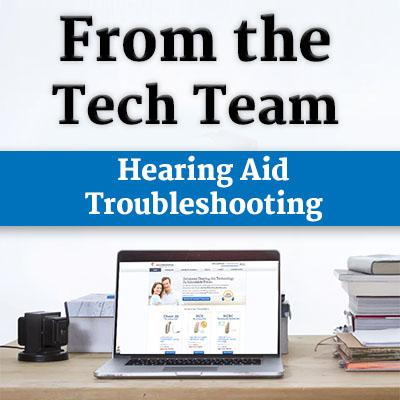
Hearing aids are like possums in that they can appear dead when they’re really not. Many experienced wearers believe hearing aids can sense the worst possible time to play dead and do so just to remind their owner to keep up on top of the maintenance schedule.
In reality, hearing aids are incredibly tough, reliable, and can often be revived by following a few simple steps.
POWER
The first step in troubleshooting non-working hearing aids is make sure the hearing aid is turned on and getting power.
- Some models use the program button as an on/off switch. Press and hold the button for three seconds for on/off function
- All models using non-rechargeable batteries use the battery door as the on/off switch. Open the battery door and then slowly close it, feeling for the resistance of the battery contacts making contact with the battery
- Any moisture in the battery compartment, even a thin film on the battery-door, can drain a battery in minutes. Make sure the entire battery compartment is dry and the battery contacts are in position to engage the battery as the battery door closes.
- Make sure you are using a good battery by testing it in the other hearing aid if possible. If the battery isn’t the problem, a blockage is the next most likely problem.
BLOCKAGES
Sound enters a hearing aid through holes in the case called microphone ports. Once amplified, the sound leaves the instrument by way of a sound tube which delivers the hearing aid’s output into the ear canal.
Normal function stops if the microphone’s input port or the hearing aid’s output tube becomes clogged.
For BTE hearing aids, the sound tubes often get clogged and require maintenance to unblock them. On RIC hearing aids (ie. Sonic Cheer), the wax guard protecting the speaker inside the tube often gets clogged instead and requires cleaning or changing.
Frequent visual inspections are important. Most owners’ manuals have helpful diagrams identifying where sound enters and exits the hearing aid. Inside the case your the hearing aids arrived in you'll find a brush/wax-loop tool designed to clean the openings. Use the brush to clean the microphone ports and the wax-loop to clean the end of the soundtube. There is also a piece of thread-like plastic that fits inside the sound tube and can be used to clear any blockages.
Is there debris in the wax guard of your Sonic hearing aid? If so, here is a list of steps to follow to change the wax guard. Take a look at the video that follows the list for more details;
- Remove the dome or “earbud” by pinching the tip and pulling it off of the tube
- Remove one Prowax MiniFit wax guard from the small black box included in your package.
- Place the black end of the MiniFit directly over the white filter tip underneath the dome, press the small black post into the white filter and tilt to the side. Now the old wax guard is removed and it’s time to put in a new one.
- Just reverse the process by taking the white-tipped end of the MiniFit directly over the hole where the prior wax guard was. Press the white tip into the hole and tilt to the side. Now you have changed the wax guard!
MOISTURE
If the hearing aid is still dead after performing the above procedures, moisture might be the issue and there are a few more things to try. For example, if the aid does not whistle when the tube is removed with the volume up, it may be a moisture issue. Open the battery door and visually check for moisture. If moisture exists, use a soft, clean microfiber lens cloth to dry it.
Since moisture is the most common cause of hearing aid failures, putting the dead hearing aid in a dry environment for a few hours can help.
- If you are at home, place the hearing aid in a dry aid jar or in a bag of dry rice overnight to pull any moisture out of the aid.
- Or you can try putting the hearing aid in a refrigerator, NOT the freezer. Leave it overnight with the battery door open to facilitate drying the interior electronics.
- If traveling by vehicle, then use the air-conditioned airflow out of a dash vent as a source of dehumidified air. Open the battery door so the cool dry air can reach the hearing aid’s interior.
Caution: Avoid using a hairdryer to dry out the moisture in your hearing aids. The possibility of causing damage from using a blow dryer is greater than benefits. Therefore, avoid using heat to dry out hearing aids.
After drying the hearing aid completely it should be working properly. If the problem has persisted after an overnight of drying, call us at 1-888-570-2740. There may be more troubleshooting procedures for specific hearing aid models.
